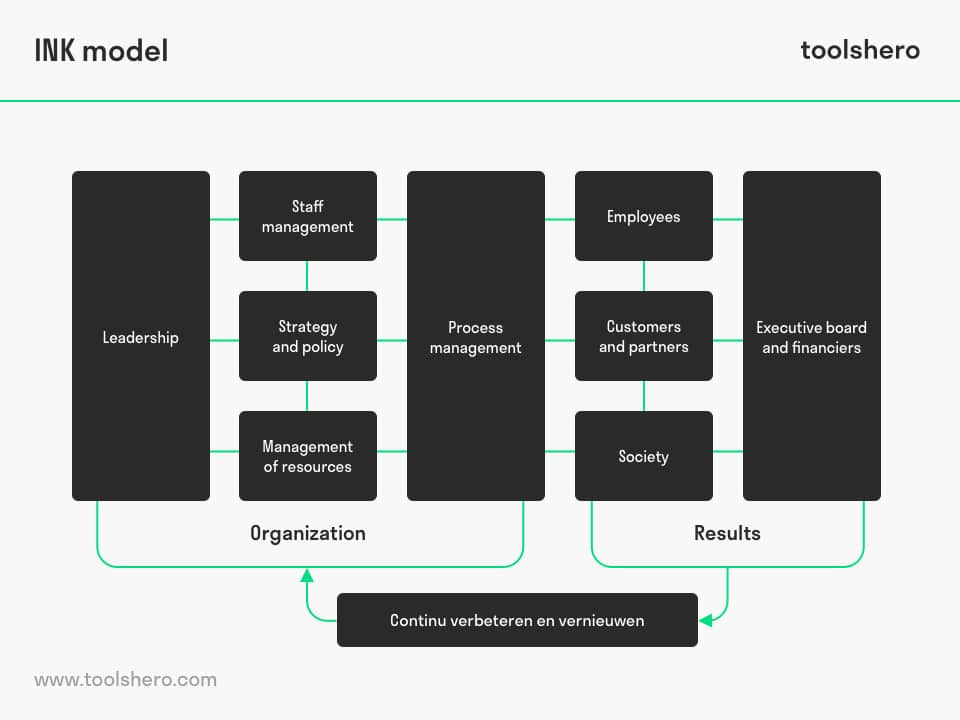INK Management Model

INK Management Model: this article explains the INK Management Model in a practical way. This article contains the definition of the INK Management Model, its 10 focus areas and practical examples. After reading you will understand the basics of this management and strategy tool. Enjoy reading!
What is the INK Management Model?
The Instituut Nederlandse Kwaliteit (INK (Institute for Dutch Quality)) is known because of the management model it has developed, the so-called INK Management Model. The vision and central idea focus on a continuous aiming at a balance within the internal stakeholders, results and efforts for the benefit of the intended performance. To achieve this, nine elements have been formulated that are managed, stabilized and standardized by applying the Deming cycle (Plan-Do-check-Act) to concur with the dynamics of organizations.
The INK model is a widely used management model and is intended to be used as a self-evaluation and control instrument. Often these self-evaluations are carried out by external and certified auditors so that an independent view of the organization is obtained. The INK management tool determines the maturity of the organization and identifies points for improvement. The INK Management Model helps organizations identify improvement potentials.
The 10 focus areas of the INK Management Model
The INK Management Model uses ten focus areas namely five organizational areas, four result areas and one area for continuous improvement that are determinative for the success of an organization. The organization areas are mainly about how the organization should be organized. The result areas are the objectives and performance that are associated with the organization. The final focus area is about the self-learning ability of the organization.

Figure 1 – INK Management Model
Leadership within the INK Management Model
Leadership within the INK Management Model is about the attitude and behaviour of all people within the organization who have a guiding responsibility and these include all the directors, managers, team leaders, etc. They should be an inspiring and driving force behind the continuous improvement of an organization. Mission, vision and the definition of strengths and raisons d’être of the organization are included in this focus area.
Staff management
Staff management is about fully using the potential of knowledge and expertise within the organization so that they can work on continuous improvement the best possible manner. In addition to recognition, appreciation and respect it is also about helping people with their personal development and making optimum use of their competences.
Strategy and Policy
The focus area of ‘Strategy and policy’ represents the way in which the organization translates its mission and vision into objectives for all people that are part of the organization. What does the mission of the organization mean to me as an individual and what does it mean for the department? What are the set objectives and how are they going to be achieved? This area focuses on how an organization can be an excellent organization through continuous improvement. Communication is an important focus area in this.
Management of Resources
This is how resources (finance, materials, information, buildings, etc) are handled within the organization. Efforts should be made to use the available resources as well as possible. Besides resources, it is also important to consider ways of cooperating with suppliers and partners to increase the added value in the chain.
Process Management
Process management is about how the organization (from strategy and policy) identifies, designs, manages , improves or innovates its processes. A distinction is made between primary, supporting and management processes. The effectiveness of the process is measured on the basis of evaluations with internal and external customers.
Employees
This focus area is about opinions and experiences of the employees. Are the employees of the organization satisfied? This is an important focal point because disgruntled employees cause customers to be dissatisfied. What is being done to make/keep the staff happy?
Customers and Partners
Valuation by customers, partners and suppliers are key factors in this as it says something about the success of the service that is provided by an organization. Alternating roles as well as prolonged and intensive cooperation can be distinguished within this area. Is the customer satisfied with the end result we have delivered and is the customers also satisfied with the way in which the end result is established? It should be noted that this could vary for the different organizations to a greater or lesser extent. What is being done to keep/make the customer happy?
Society
This focus area says something about the organization’s position within society. Socially Responsible Entrepreneurship says something about issues such as the environment, society and the developments within these areas. These are the key elements in this focus area. What does the organization do for society and how is this perceived by society? (recycling, childcare centres are examples of this). Active involvement in society is therefore important is this focus area.
Executive board and financiers
The continuity of an organization is largely determined by the executive board and its potential financiers. This focus area is mainly about the financial as well as the operating results which are supposed to be in line with the strategic objectives, the expected yields and any advancement in the market position.
The organization must ask itself to what extent it is capable of achieving its (financial and operational) objectives. To what extent does the organization meet the expectations of financial stakeholders? Benchmarking, comparing results with other companies, is a favourite tool in this.
Continuous Improvement and Innovation
This continuous Improvement and innovation focus area is about the condition of the organization. Is the organization able to follow the dynamics of the market, to do more with less in times of austerity and can continuous effectiveness be improved? Reflection, adoption of information, technology and new developments are primary issues in this focus area.
The Five fundamental characteristics
The INK model is a practical management model that is based on the structure and cultures of successful European organizations. This is why the INK model has five fundamental characteristics, namely:
1. Inspirational Leadership
Leadership throughout the organization top-down, driven by vision, realistic ambitions and commitment.
2. Building on trust by using the INK Management model
Everyone knows what their contribution should be to achieve a good overall result.
3. Cooperation through using the INK Management model
Together we are stronger and therefore we can achieve more. Respect for each other and shared responsibility contribute to achieving success.
4. Result oriented
The people with managerial responsibilities focus on results and balance the valuations of stakeholders.
5. Continuous improvement and innovation, based on using the INK Management model
Time and attention is necessary for critical self-reflection and improvement. Trends and exceptional deviations are analysed and address by sustainable improvements.
It’s Your Turn
What do you think? What is your experience with the INK Management Model? Do you recognize the practical explanation or do you have more suggestions? What are your success factors for using and following a widely used management model?
Share your experience and knowledge in the comments box below.
More information
- INK (2014). INK-managementmodel. website INK: https://www.ink.nl/, website visited on 22-04-2014.
- Ahaus, K. & Diepman, F. (2005). Balanced scorecard & INK management Tool. Kluwer.
- Dorr, D., & Zuidema, J. (2002). Werken met het INK – managementmodel. Kluwer.
How to cite this article:
Van Vliet, V. (2009). INK Management Model. Retrieved [insert date] from Toolshero: https://www.toolshero.com/strategy/ink-management-model/
Original publication date: 03/14/2018 | Last update: 07/05/2023
Add a link to this page on your website:
<a href=”https://www.toolshero.com/strategy/ink-management-model/”>Toolshero: INK Management Model</a>






